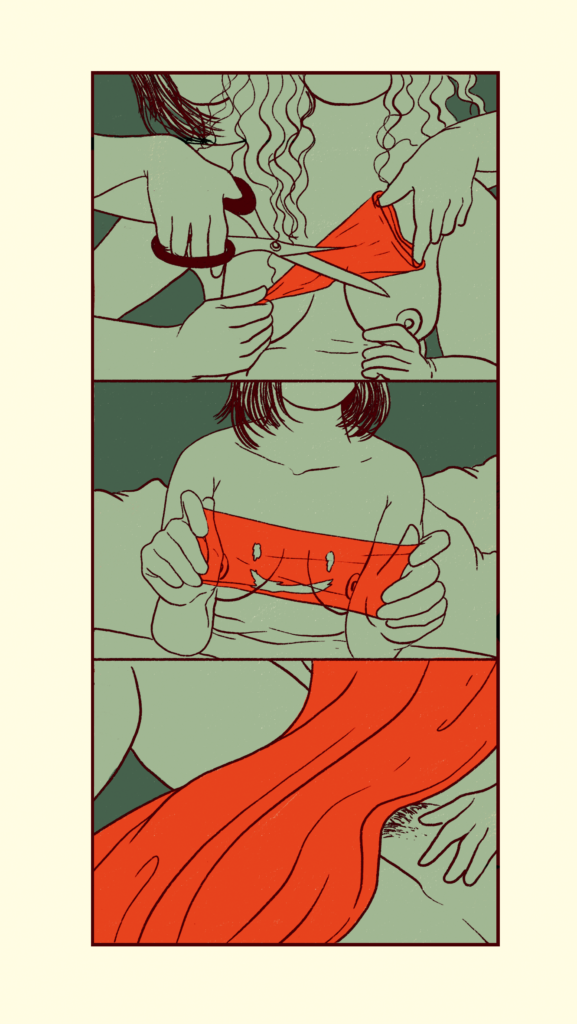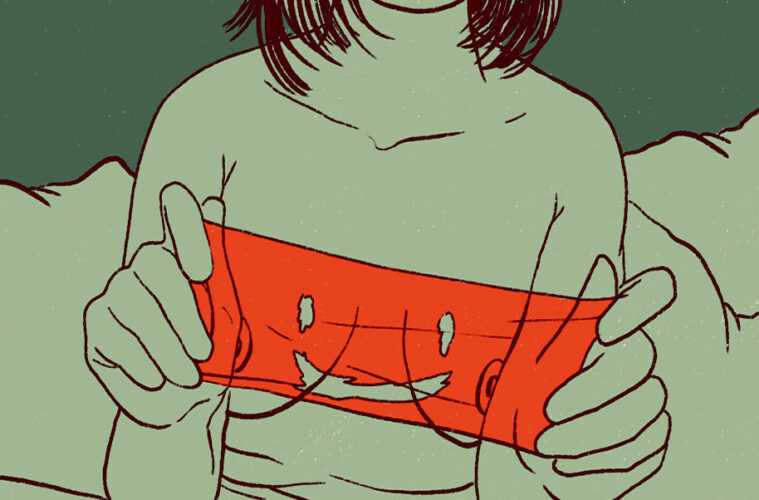Words by Ram*
Translation by Hiba Moustafa
Illustrations by Merieme Mesfioui
Remembering the Night of April 1st, 2020
When life hit us hard at the beginning of quarantines and news about epidemics, viruses, and death by close contact was everywhere, we lost touch with our common spaces, places, routines, and loved ones. I remember that I lost my sex life, too. Having casual sex or one-night stands was challenging, burdensome, and rare. There were no bars to “shake it” with each other or nightclubs to sway with new people interested in spending the night with us. We turned our attention to our bubbles – as authorities called them – of friends, acquaintances, and families. We spent more time at home or at a friend’s, where we talked, drank, and watched films. Old new faces came into our lives again but under new definitions.
I was open with my friends about losing my sexual space. One night, I told Samer* that I missed sex and that I thought I needed it, particularly since we were living at such a cold time when we had no touches or kisses. I said to him simply, “The bed is cold and I’m horny.” He said he had heard that complaint a lot and that he knew we had a mutual friend who was lesbian like me and who missed sex. He asked if I was interested in getting closer to her, and if I was OK with him asking her if she wanted the same and to maybe sleep with me in the future.
I was thrilled about Samer’s suggestion and really open to that option. Days later, he told me that she was also interested and that we should set a date to see each other and watch a movie. He also said that our mutual friend and I could spend the night on his couch if we wished, assuring me that this was going to be a private space and that we would have the privacy to do whatever we wanted. We were all on the same page.
I’d known Maya* for a while, but only superficially. I had seen her in common spaces, and I thought she was beautiful, lively, and sweet. We had never been intimate before; the closest we ever got was dancing at some party. Lately, we had mutual acquaintances and got closer because of movement restrictions during quarantine. A bunch of coincidences brought us together in closer circles.
We met at Samer’s and had a few drinks. We sat close to each other, with her arm around my shoulder. It was a nice and cozy feeling. I got ahead of myself and was turned on. We were watching a Spanish movie I think. It ended and Samer and his girlfriend left, bidding us goodnight.
We hugged, got closer, lay down, and kissed each other. The smell of horniness was everywhere. I was aroused, mentally and sexually. We took off our shirts, rubbed and touched each other. Then, I put my hand on her pussy and started to unbutton her pants. I told her I wanted to eat her out, but she said, “Not tonight.” We continued, and I put my hand into her pants; she did the same to me. When I licked my fingers, she told me to stop and that we needed to talk.
We sat next to each other with obvious seriousness. She said, “You have full freedom to change your mind about having sex with me after I tell you this.” I listened, and she said that she had herpes simplex virus 1 (HSV-1). She asked me to look up the virus and read about it before I decided to exchange any kind of sexual fluids with her or put my mouth or pussy on hers. She added that there was no permanent cure, so she had to deal with one episode of symptoms at a time, and that symptoms are more severe on some days than others. She talked in detail about the difference between type 1 and type 2, telling me to ask her about anything I had in mind. I asked her if I should wash my hands after touching her; she said that I should. After I got back from the bathroom, we continued our kisses and superficial touches until we felt drowsy and slept next to each other, the first of many times to come.
The Simple Search Journey: A Dead End
I have heard about HSV before and I know that many people carry it – most of the world’s population as far as I can recall. But this was the first time to come face to face with such questions and choices on an intimate night, and so directly and personally.
Following Maya’s request, I started researching and reading about the virus in depth. Information about it, how it looks, where it exists in neurons, how it hides, and how it appears is abundant. The footnotes of medical articles and heterosexual sex forums provide information on having “safe sex” with carriers. Their rhetoric is the same in that it can be summarized into one sentence: I use condoms.
This enraged me; neither Maya nor I have a penis.
“Wait a minute …,” I murmured.
Is lesbian “safe sex” possible? What are our safe options – if any – if we decided to continue having sex? Should the sex we have be penetrative, using just a dildo so we can enjoy the benefits of safe sex scientific research?
I searched keywords – motivated by anger, rage, and violent keyboard clicking – from “HSV” to “lesbian safe sex.”
Some medical articles – far fewer than those that can be summarized into “I use condoms” – discussed sexual diseases that may be transmitted during fluid exchange and sexual contact between two women. Little was said besides checking genitals for any blisters or color change (I’ll comment soon on why this proposition is problematic). A few articles talked about safe sex using sex toys. Here, the penis comes up once again as the quick solution: “Put a condom on the dildo and wash it before and after use.” Thank you very much, but no! What if I wanted to have non-penetrative sex?
A tool that I haven’t heard of before — and I’m sure many of you haven’t – started to show up: dental dam. In Arabic, it’s literally translated into “سد الأسنان” (we have yet to come up with a non-literal equivalent and I’m not in the least interested in coming up with one).
A dental dam is a latex membrane usually used by dentists. In oral sex, it is placed like a tablecloth on the vulva to form a barrier between it and the mouth.

Illustration by Merieme Mesfioui
Search Monologue:
Where should it be fixed? It cannot be fixed. It is moveable then? Exactly! It’s not practical, but that is what we have. It is a medical tool; it’s not designed for sex and it isn’t sexy too.
I do another search, deleting the old keywords. I write “mental dam + how can I have it?” But there’s no clear answer. I visit the website of the biggest pharmacy in the country I live in. I type “d e n t a l d a m” and click search.
Uhm, well, let me use simpler keywords; maybe it’s classified under other names. I try “female condom.”
Gosh! OK, let me not rush to conclusions. Maybe there’s some technical problem with their search engine. I will try another common product: c o n d o m s.
Everything is normal then. There is nothing new under the sun.
A new search: “how to get a dental dam”.
Results: make it out of a condom.
The real result: the only tool that is available for lesbians to have safe sex isn’t sold in an environment that champions gay sexual liberation and holds one of the biggest pride parades. It is being made from another tool that is designed, engineered, researched, and conceived with the penis being the center of attention.

Illustration by Merieme Mesfioui
Doubled Burden: Violating the Infected Female Body
During that night, the burden of education and awareness lay on Maya, as it does on lesbians with multiple types of STIs. Disclosing one’s medical history becomes a collective health “duty” among lesbians when there’s no “condom” that can be used to preserve one’s confidentiality, privacy, history, and intimate details. This burden is carried by the infected woman every time she has sex: sitting down, talking, disclosing, being patient, and facing potential rejection, shame, or even insults. How can lesbians be expected to lead a fulfilling, queer sexual life – or a quick, spontaneous, and secret sexual life if they wished – if each and every time we hang out with or touch somebody, there need to be these introductions, a biology class, and a detailed report on the case’s severity, development, and peak time?
The burden does not stop here. Medical articles, as I mentioned earlier, recommend running a visual check of one’s partner’s body and genitals to detect any blisters or ulcers. The body of the infected person becomes an exhibition, a spectacle, and a target for suspicion and doubt. One doesn’t use her eyes to appreciate the body, its beauty, and sexiness, but to run a medical examination with strong lights on and extreme caution to look for some “defect.” That if we assumed that this kind of examination and voyeurism is normal, required, proper, and accepted.
These articles assume that the sexual partner of the infected person is entitled to this level of information or examinations. This is highly debatable, for, in the absence of STI prevention solutions for lesbians, we must ask ourselves if the other party has the right to know or even request all this information, and whether it is ethically problematic when the infected party decides to hide this information.
I define “consent” as two parties’ temporary and renewable agreement to do a certain deed, whether it is verbal, physical, or sexual, on the condition that all necessary information is available to make a fully informed decision to do this deed. This means that hiding information like the possibility of me having an STI may change the form of initial consent and render it void. On the other hand, the possibility of contracting an STI is almost non-existent if the two partners were wearing condoms, which makes consent something clear and uncomplicated: I agreed to have sex with someone who wears a condom.
The burden is further complicated when scientific papers and health community articles recommend using sex toys and dildos as an easy escape from being infected, because we can wash or put condoms on them and that’s it. This imposes sexual practices on lesbians they may not like or feel comfortable with. Assuming that all lesbians are comfortable with dildos or penetration is violent and exclusionary, and can force them into experiences that aren’t representative of desires. It is an assumption that erases and marginalizes a huge number of sexual practices –including touching and foreplay that require direct physical contact – and marginalizes whoever wishes to experience them.
The outcome of these assumptions about sex is that giving and taking consent becomes complicated and that lesbians are forced to compromise and make uncomfortable disclosures. And, they are forced to take more caution than men because of the lack of easy and accessible tools, like condoms, to have safe sex. This screaming lack of access to safe sex contraptions for lesbians hinders the possibility for many to explore open and queer relationships with multiple partners, rather some would resort to exclusivity and monogamy. Bodies will be scrutinized. It’s complicated and burdensome, and privacy is straight out of the door.
Why Should We Talk about STI Prevention Justice Now?
Lesbians are overlooked in the rhetoric of LGBTQ-funded organizations in the Arabic-speaking region (and globally, too). These organizations distribute free condoms and post videos on how to wear them, but no one questions the exclusivity of this narrative, whom it overlooks, and why. Where are lesbians in the rhetoric of those who claim to represent them, talk about them, and fight for their rights?
A cohort of scientific studies assert the STI prevention gap. For example, one study shows that many lesbians don’t know that HIV can be transmitted via lesbian sex,1 which is an expected result of the fact that most ads about HIV prevention targets gay men, particularly those about PrEP.2 Try looking up “lesbian” or “woman” in the attached article about STI prevention and you will have a clear picture of what I’m discussing. Strangely enough, lesbians were the most prominent fighters for safe sex rights against the State’s lethargy during the AIDS pandemic.3 4
Most of the funding and development of sexual protection for women focus on reproduction; but even in this domain, there is still an imbalance between contraceptives made for men and those made for women and their side effects. Sterile sex that doesn’t produce children, or a potential workforce, has no place in the equation. Research is biased toward women’s birth control and against women’s safe sex; safety, here, is understood only as preventing reproduction and regulating the family unit in alignment with the states/authorities’ objectives, here and now. Men’s contraceptives, however, focus on their pleasure: Durex Pleasure, Durex Intense, etc. This imbalance is clear too in the most “progressive” TV shows and series that address safe sex; Heartbreak High and Sex Education are two examples. The penis is revered and worshipped in society, studies, and research, even gay men’s penises when they have this “sterile sex.”
By not talking about STI prevention justice, we put a large number of lesbians at great risk. They face marginalization, their sexual practices fade, and they bear the entire burden of educating, restraining, and disclosing, the burden of being examined, rejected, and exposed … in addition to managing the STI itself!
There is no archive (in English or Arabic) or history that talks about lesbian women’s struggles with unsafe sex. Try looking up articles that discuss the history of STI prevention for/among men and you will find papers and narratives on the development of the condom and the enormous scientific achievement. Then try looking up articles on the history of STI prevention among lesbians, and you will find totally different results. You will find scientific papers on the little involvement of lesbian women in STI prevention campaigns and the difficulties in spreading dental dams in society.
By not talking about STI prevention justice, we erase the history of lesbians and forget their tangible experiences. What we see is that our bodies do not matter, that they are replaceable and susceptible to sickness, and that spending on developing a new tool for us – for our sexual lives, for our safety, and for the protection of societies and partners – doesn’t matter historically and is not a priority. First, we have to be angry then we talk about STI prevention justice and the gap that swallows lesbians out of the spotlight, funding, and research. We have to talk about this to bring our narrative and needs to the forefront again and to force organizations and funders to fund our safety. We have to talk about justice because it touches us and touches our bodies, our privacy, our relationships, and our most intimate expressions. And, it touches our queerness, our choices, our desires, and sexual freedoms. We have to talk about it because we are not safe until we all have safety means and the right to choose what to do with them. We have to talk about it lest hundreds of years come and go and lesbians still have to make silly and ridiculous dental dams5 out of condoms.
* The author’s name, and those used in the article, are pseudonyms to protect their privacy and safety.
- Stevens, P.E. and Hall, J.M., 2001. Sexuality and safer sex: The issues for lesbians and bisexual women. Journal of Obstetric, Gynecologic, & Neonatal Nursing, 30(4), pp.439-447.
- Arana, G., 2020. PrEP: The Story of a Sexual Revolution. Them. [Published on March 16th, 2020, accessed on September 25th 2022:https://www.them.us/story/prep-the-story-of-a-sexual-revolution#:~:text=The%20Federal%20Drug%20Administration%20first,with%20men%20and%20transgender%20people].
- Brier, J., 2007. Locating Lesbian and feminist responses to AIDS, 1982-1984. Women’s Studies Quarterly, 35(1/2), pp.234-248.
- Rodriguez, M., u.d.. Lesbians on the Front Lines: Meet the Queer Women Who Cared for People With AIDS During the Epidemic’s Height. [Accessed on September 25th 2022: https://www.thebody.com/gallery/gallery/lesbians-front-lines-hiv-aids]
- Elizabeth, A., 2019. Nobody Uses Dental Dams. The Atlantic. [Published on April 21st, 2019, accessed on September 25th 2022: https://www.theatlantic.com/health/archive/2019/04/dental-dams-are-more-symbolic-practical/587539/].

